Kyocera FS C5025N User Manual
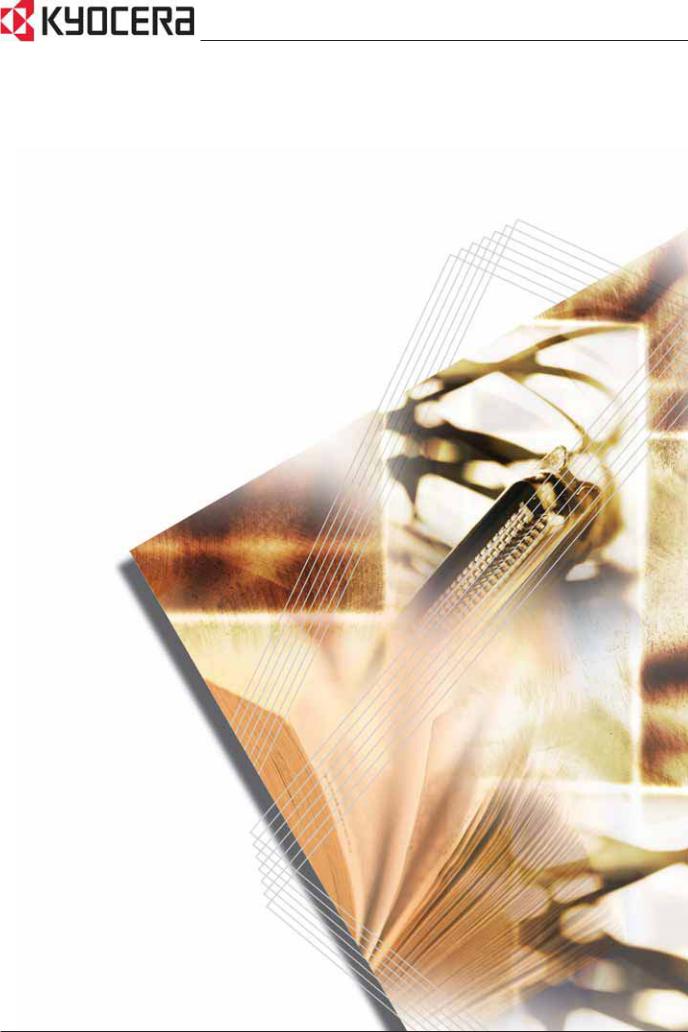
FS-C5015N
FS-C5025N
FS-C5030N
Advanced Operation Guide

Contents
1 |
Handling Paper |
|
|
General Guidelines . . . . . . . . . . . . . . . . . . . . . . . . . . . . . . . . . . . . . . . . . . . . . . . . . . . . . . . . . |
. 1-2 |
|
Selecting the Right Paper . . . . . . . . . . . . . . . . . . . . . . . . . . . . . . . . . . . . . . . . . . . . . . . . . . . . |
. 1-4 |
|
Paper Type . . . . . . . . . . . . . . . . . . . . . . . . . . . . . . . . . . . . . . . . . . . . . . . . . . . . . . . . . . . . . . . . |
1-12 |
|
Loading Paper . . . . . . . . . . . . . . . . . . . . . . . . . . . . . . . . . . . . . . . . . . . . . . . . . . . . . . . . . . . . . |
1-13 |
2 |
Using the Operator Panel |
|
|
General Information . . . . . . . . . . . . . . . . . . . . . . . . . . . . . . . . . . . . . . . . . . . . . . . . . . . . . . . . . |
. 2-2 |
|
Understanding the Operator Panel . . . . . . . . . . . . . . . . . . . . . . . . . . . . . . . . . . . . . . . . . . . . . |
. 2-3 |
|
Canceling a Printing Job . . . . . . . . . . . . . . . . . . . . . . . . . . . . . . . . . . . . . . . . . . . . . . . . . . . . . |
2-10 |
|
Using the Menu Selection System . . . . . . . . . . . . . . . . . . . . . . . . . . . . . . . . . . . . . . . . . . . . . . |
2-11 |
|
Status Pages . . . . . . . . . . . . . . . . . . . . . . . . . . . . . . . . . . . . . . . . . . . . . . . . . . . . . . . . . . . . . . |
2-15 |
|
e-MPS . . . . . . . . . . . . . . . . . . . . . . . . . . . . . . . . . . . . . . . . . . . . . . . . . . . . . . . . . . . . . . . . . . . |
2-18 |
|
Changing the Interface Parameters . . . . . . . . . . . . . . . . . . . . . . . . . . . . . . . . . . . . . . . . . . . . . |
2-29 |
|
Making Default Settings . . . . . . . . . . . . . . . . . . . . . . . . . . . . . . . . . . . . . . . . . . . . . . . . . . . . . . |
2-37 |
|
Pagination . . . . . . . . . . . . . . . . . . . . . . . . . . . . . . . . . . . . . . . . . . . . . . . . . . . . . . . . . . . . . . . . |
2-44 |
|
Setting Print Quality . . . . . . . . . . . . . . . . . . . . . . . . . . . . . . . . . . . . . . . . . . . . . . . . . . . . . . . . . |
2-49 |
|
Operating the Storage Device . . . . . . . . . . . . . . . . . . . . . . . . . . . . . . . . . . . . . . . . . . . . . . . . . |
2-51 |
|
Paper Handling . . . . . . . . . . . . . . . . . . . . . . . . . . . . . . . . . . . . . . . . . . . . . . . . . . . . . . . . . . . . |
2-60 |
|
Selecting Monochrome or Color Printing . . . . . . . . . . . . . . . . . . . . . . . . . . . . . . . . . . . . . . . . . |
2-74 |
|
Reading Life Counters . . . . . . . . . . . . . . . . . . . . . . . . . . . . . . . . . . . . . . . . . . . . . . . . . . . . . . . |
2-75 |
|
Other Modes . . . . . . . . . . . . . . . . . . . . . . . . . . . . . . . . . . . . . . . . . . . . . . . . . . . . . . . . . . . . . . |
2-77 |
3 |
Options |
|
|
General Information . . . . . . . . . . . . . . . . . . . . . . . . . . . . . . . . . . . . . . . . . . . . . . . . . . . . . . . . . |
. 3-2 |
|
Expansion Memory Modules . . . . . . . . . . . . . . . . . . . . . . . . . . . . . . . . . . . . . . . . . . . . . . . . . . |
. 3-3 |
|
General Description of Options . . . . . . . . . . . . . . . . . . . . . . . . . . . . . . . . . . . . . . . . . . . . . . . . . |
3-6 |
|
IB-21E/IB-23 Network Interface Cards . . . . . . . . . . . . . . . . . . . . . . . . . . . . . . . . . . . . . . . . . . . |
3-10 |
4 |
Computer Interface |
|
|
|
General Information . . . . . . . . . . . . . . . . . . . . . . . . . . . . . . . . . . . . . . . . . . . . . . . . . . . . . . . . . |
. 4-2 |
|
|
Parallel Interface (FS-C5030N only) . . . . . . . . . . . . . . . . . . . . . . . . . . . . . . . . . . . . . . . . . . . . |
. 4-3 |
|
|
USB Interface . . . . . . . . . . . . . . . . . . . . . . . . . . . . . . . . . . . . . . . . . . . . . . . . . . . . . . . . . . . . . . |
. 4-5 |
|
|
Serial Interface (FS-C5030N only) . . . . . . . . . . . . . . . . . . . . . . . . . . . . . . . . . . . . . . . . . . . . . . |
. 4-6 |
|
|
RS-232C |
Protocol (FS-C5030N only) . . . . . . . . . . . . . . . . . . . . . . . . . . . . . . . . . . . . . . . . . . . |
. 4-7 |
|
RS-232C |
Cable Connection (FS-C5030N only) . . . . . . . . . . . . . . . . . . . . . . . . . . . . . . . . . . . . |
4-10 |
Glossary
Index
ADVANCED OPERATION GUIDE |
i |

Contents
ii |
ADVANCED OPERATION GUIDE |

Introduction
This guide has the following chapters:
•1 Handling Paper
Explains how choose, handle and load paper.
•2 Using the Operator Panel
Explains how to use the operator panel to configure the printer.
•3 Options
Shows the available options.
•4 Computer Interface
Describes the possible connections between the printer and your computer.
•Glossary
A Glossary of terms used is provided here.
ADVANCED OPERATION GUIDE |
iii |

Introduction
Conventions
This manual uses the following conventions:
Convention |
Description |
|
Example |
|
|
|
|
|
|
Italic Typeface |
Used to emphasize a key word, |
|
Close the top cover. |
|
|
phrase or message. In addition, |
|
Refer to Toner Container Replacement |
|
|
references to other publications |
|
on page 3-3. |
|
|
are displayed in italic typeface. |
|
|
|
|
|
|
|
|
Bracket Bold Text |
Used to emphasise the |
|
Press [Copy]. |
|
Typeface |
selection of a feature mode or |
|
|
|
|
key. |
|
|
|
|
|
|
|
|
Notes |
Used to provide additional or |
|
|
|
NOTE: For information about storing the |
|
|||
|
useful information about a |
|
|
|
|
function or feature. Can also |
|
pin, refer to step 10. |
|
|
contain references to other |
|
|
|
|
publications. |
|
|
|
|
|
|
|
|
Important |
Use to provide important |
|
|
|
IMPORTANT: Ensure paper is not |
|
|||
|
information. |
|
|
|
|
|
|
folded, curled, or damaged. |
|
|
|
|
|
|
Caution |
Cautions are statements that |
|
|
|
CAUTION: Do not pull the cassette out |
|
|||
|
suggest mechanical damage as |
|
|
|
|
a result of an action. |
|
when holding the front of the machine. |
|
|
|
|
|
|
|
|
|
|
|
Warning |
Used to alert users to the |
|
WARNING: High voltage is present |
|
|
possibility of personal injury. |
|
in the charger section. |
|
|
|
|
|
|
iv |
ADVANCED OPERATION GUIDE |

1 Handling Paper
This chapter contains explanations on the following topics:
• |
General Guidelines....................................................... |
1-2 |
• Selecting the Right Paper............................................. |
1-4 |
|
• |
Paper Type................................................................. |
1-12 |
• |
Loading Paper............................................................ |
1-13 |
ADVANCED OPERATION GUIDE |
1-1 |

Handling Paper
General Guidelines
The machine is designed to print on standard copier paper (the type used in ordinary dry copier machines), but it can also accept a variety of other types of paper within the limits specified below.
NOTE: The manufacturer assumes no liability for problems that occur when paper not satisfying these requirements is used.
Selection of the right paper is important. Using the wrong paper can result in paper jams, curling, poor print quality, and paper waste, and in extreme cases can damage the machine. The guidelines given below will increase the productivity of your office by ensuring efficient, trouble-free printing and reducing wear and tear on the machine.
Paper Availability
Most types of paper are compatible with a variety of machines. Paper intended for xerographic copiers can also be used with the machine.
There are three general grades of paper: economy, standard, and premium. The most significant difference between grades is the ease with which they pass through the machine. This is affected by the smoothness, size, and moisture content of the paper, and the way in which the paper is cut. The higher the grade of paper you use, the less risk there will be of paper jams and other problems, and the higher the level of quality your printed output will reflect.
Differences between paper from different suppliers can also affect the machine’s performance. A high-quality printer cannot produce high-quality results when the wrong paper is used. Low-priced paper is not economical in the long run if it causes printing problems.
Paper in each grade is available in a range of basis weights (defined later).
The traditional standard weights are 60 to 105 g/m² (16 to 28 pounds).
Paper Specifications
The following table summarizes the basic paper specifications. Details are given on the following pages.
Item |
Specification |
|
|
Weight |
Cassette: 60 to 105g/m² (16 to 28 lb/ream) |
|
MP Tray: 60 to 200g/m² (16 to 53 lb/ream) |
|
|
Thickness |
0.086 to 0.110mm (3.4 to 4.3 mils) |
|
|
Dimensions |
See Paper Sizes on page 1-4 |
|
|
Dimensional accuracy |
±0.7mm (±0.0276 inches) |
|
|
Squareness of corners |
90° ±0.2° |
|
|
1-2 |
ADVANCED OPERATION GUIDE |
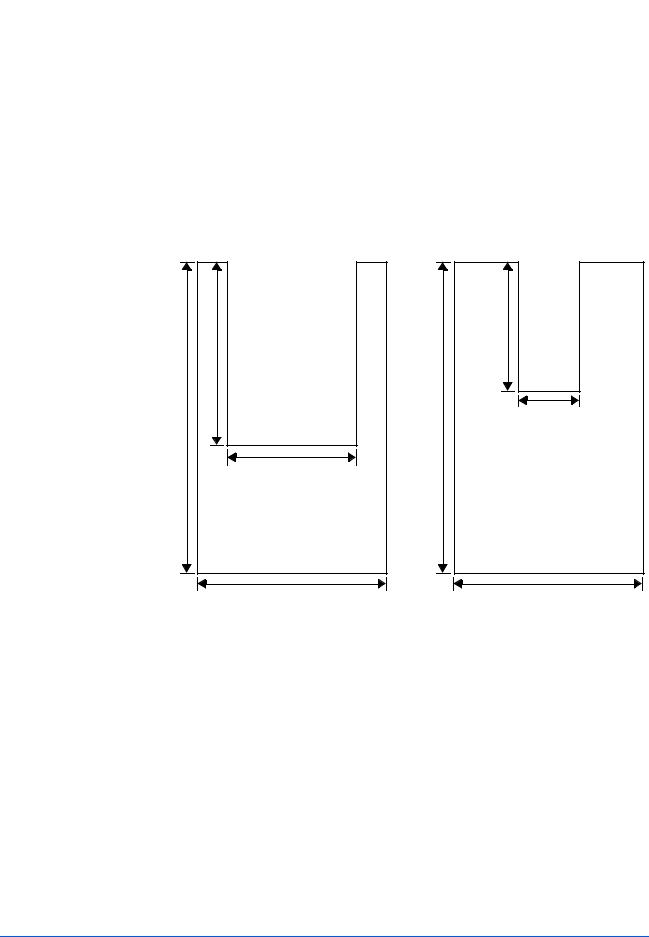
|
|
Handling Paper |
|
|
|
|
|
|
|
Item |
Specification |
|
|
|
|
Moisture content |
4% to 6% |
|
|
|
|
Direction of grain |
Long grain |
|
|
|
|
Pulp content |
80% or more |
|
|
|
Minimum and Maximum Paper Sizes
The minimum and maximum paper sizes are as follows. For non standard paper, the MP tray must be used.
Paper cassette |
|
MP tray |
||
|
inches1/4-8 |
Minimum |
|
148mm inches13/16-5 |
|
Paper Size |
|
||
|
|
|
|
|
|
210mm |
|
|
|
356mm |
14 inches |
148mm |
356mm |
14 inches |
|
|
|
|
|
|
|
5-13/16 inches |
|
|
|
|
Maximum |
|
|
|
|
Paper Size |
|
|
|
|
216mm |
|
|
|
|
8-1/2 inches |
|
|
Minimum
Paper Size
70mm 2-13/16 inches
Maximum
Paper Size
216mm 8-1/2 inches
Recommended Paper
The following products are recommended for use with the printer for optimum performance.
Size |
Product |
Weight |
|
|
|
Letter, Legal |
Hammermill LASER PRINT |
90 g/m² (24 lb) |
|
|
|
A4 |
NEUSIEDLER COLOR COPY |
90 g/m² |
|
|
|
ADVANCED OPERATION GUIDE |
1-3 |

Handling Paper
Selecting the Right Paper
This section describes the guidelines for selecting paper.
Condition
Avoid using paper that is bent at the edges, curled, dirty, torn, embossed, or contaminated with lint, clay, or paper shreds.
Use of paper in these conditions can lead to illegible printing and paper jams, and can shorten the life of the machine. In particular, avoid using paper with a surface coating or other surface treatment. Paper should have as smooth and even a surface as possible.
Composition
Do not use paper that has been coated or surface-treated and contains plastic or carbon. The heat of fusing can cause such paper to give off harmful fumes.
Bond paper should contain at least 80 % pulp. Not more than 20 % of the total paper content should consist of cotton or other fibers.
Paper Sizes
Cassettes and the MP Tray are available for the paper sizes listed in the table below. The dimensional tolerances are ±0.7mm (±0.0276 inches) for the length and width. The angle at the corners must be 90° ±0.2°.
MP tray |
Size |
Cassette or |
Size |
|
MP tray |
||||
|
|
|
||
|
|
|
|
|
Envelope Monarch |
3-7/8 × 7-1/2 |
Legal |
8-1/2 × 14 inches |
|
|
inches |
|
|
|
|
|
|
|
|
Envelope #10 |
4-1/8 × 9-1/2 |
Letter |
8-1/2 × 11 inches |
|
|
inches |
|
|
|
|
|
|
|
|
ISO A6 |
105 × 148mm |
ISO A4 |
210 × 297mm |
|
|
|
|
|
|
Envelope DL |
110 × 220mm |
ISO A5 |
148 × 210mm |
|
|
|
|
|
|
Envelope #9 |
3-7/8 × 8-7/8 |
Envelope C5 |
162 × 229mm |
|
|
inches |
|
|
|
|
|
|
|
|
Envelope #6 |
3-5/8 × 6-1/2 |
ISO B5 |
176 × 250mm |
|
|
inches |
|
|
|
|
|
|
|
|
JIS B6 |
128 × 182mm |
JIS B5 |
182 × 257mm |
|
|
|
|
|
|
Statement |
5-1/2 × 8-1/2 |
Executive |
7-1/4 × 10-1/2 inches |
|
|
inches |
|
|
|
|
|
|
|
|
Hagaki |
100 × 148mm |
Oficio II |
8-1/2 × 13 inches |
|
|
|
|
|
|
Ofuku-Hagaki |
148 × 200mm |
Folio |
210 × 330mm |
|
|
|
|
|
1-4 |
ADVANCED OPERATION GUIDE |

|
|
|
|
Handling Paper |
|
|
|
|
|
|
|
|
|
|
|
MP tray |
Size |
Cassette or |
Size |
|
MP tray |
|||
|
|
|
|
|
|
|
|
|
|
|
Youkei 2 |
114 × 162mm |
16 kai |
197mm × 273mm |
|
|
|
|
|
|
Youkei 4 |
105 × 235mm |
|
|
|
|
|
|
|
|
Custom |
Cassette: |
|
|
|
|
148 to 216mm × 210 to 356mm |
|
|
|
|
(5-13/16 to 8-1/2 inches × 8-1/4 to 14 inches) |
||
|
|
MP tray: |
|
|
|
|
70 to 216mm × 148 to 356mm |
|
|
|
|
(2-13/16 to 8-1/2 inches × 5-13/16 to 14 inches) |
||
|
|
|
|
|
Smoothness
The paper should have a smooth, uncoated surface. Paper with a rough or sandy surface can cause voids in the printed output. Paper that is too smooth can cause multiple feeding and fogging problems. (Fogging is a gray background effect.)
Basis weight
Basis weight is the weight of paper expressed in grams per square meter (g/m²). Paper that is too heavy or too light may cause feed errors or paper jams as well as premature wear of the product. Uneven weight of paper, namely uneven paper thickness may cause multiple-sheet feeding or print quality problems such as blurring because of poor toner fusing.
The recommended basis weight is between 60 and 105 g/m² (16 and 28 lb/ream) for the cassette and between 60 and 200 g/m² (16 and 53 lb/ ream) for the MP tray.
Paper Weight Equivalence Table
The paper weight is listed in pounds (lb) and metric grams per square meter (g/m²). The shaded part indicates the standard weight.
U. S. Bond Weight (lb) |
Europe Metric Weight (g/m²) |
|
|
16 |
60 |
17 |
64 |
|
|
20 |
75 |
21 |
80 |
22 |
81 |
|
|
24 |
90 |
27 |
100 |
28 |
105 |
32 |
120 |
|
|
ADVANCED OPERATION GUIDE |
1-5 |

Handling Paper
U. S. Bond Weight (lb) |
Europe Metric Weight (g/m²) |
|
|
34 |
128 |
|
|
36 |
135 |
39 |
148 |
|
|
42 |
157 |
|
|
43 |
163 |
|
|
47 |
176 |
|
|
53 |
199 |
|
|
Thickness
The paper used with the machine should be neither extremely thick nor extremely thin. If you are having problems with paper jams, multiple feeds, and faint printing, the paper you are using may be too thin. If you are having problems with paper jams and blurred printing the paper may be too thick. The correct thickness is 0.086 to 0.110mm (3.4 to 4.3 mils).
Moisture Content
Moisture content is defined as the percent ratio of moisture to the dry mass of the paper. Moisture can affect the paper’s appearance, feed ability, curl, electrostatic properties, and toner fusing characteristics.
The moisture content of the paper varies with the relative humidity in the room. When the relative humidity is high and the paper absorbs moisture, the paper edges expand, becoming wavy in appearance. When the relative humidity is low and the paper loses moisture, the edges shrink and tighten, and print contrast may suffer.
Wavy or tight edges can cause jams and alignment anomalies. The moisture content of the paper should be 4 to 6 %.
To ensure correct moisture content, it is important to store the paper in a controlled environment. Some tips on moisture control are:
•Store paper in a cool, dry location.
•Keep the paper in its wrapping as long as possible. Re-wrap paper that is not in use.
•Store paper in its original carton. Place a pallet etc. under the carton to separate it from the floor.
•After removing paper from storage, let it stand in the same room as the machine for 48 hours before use.
•Avoid leaving paper where it is exposed to heat, sunlight, or damp.
Paper Grain
When paper is manufactured, it is cut into sheets with the grain running parallel to the length (long grain) or parallel to the width (short grain). Short
1-6 |
ADVANCED OPERATION GUIDE |

Handling Paper
grain paper can cause feeding problems in the machine. All paper used in the machine should be long grain.
Other Paper Properties
Porosity: Indicates the density of paper fiber.
Stiffness: Limp paper may buckle in the machine, resulting in paper jams.
Curl: Most paper naturally tends to curl one way if left unpacked. When paper passes through the fixing unit, it curls upward a little. To produce flat printouts, load the paper so that the upward pressure from the machine can correct their curling.
Electrostatic discharge: During the printing process the paper is electrostatically charged to attract the toner. The paper must be able to release this charge so that printed sheets do not cling together in the
Output Tray.
Whiteness: The contrast of the printed page depends on the whiteness of the paper. Whiter paper provides a sharper, brighter appearance.
Quality control: Uneven sheet size, corners that are not square, ragged edges, welded (uncut) sheets, and crushed edges and corners can cause the machine to malfunction in various ways. A quality paper supplier should take considerable care to ensure that these problems do not occur.
Packaging: Paper should be packed in a sturdy carton to protect it from damage during transport. Quality paper obtained from a reputable supplier is usually correctly packaged.
Special Paper
The following types of special paper can be used:
Paper type to be used |
Paper type to be selected |
|
|
Thin paper (60 to 64 g/m²) |
Vellum |
Thick paper (90 to 200 g/m²) |
Thick |
Colored paper |
Color |
Recycled paper |
Recycled |
Overhead projector transparencies |
Transparency |
Postcards |
Cardstock |
Envelopes |
Envelope |
Label |
Labels |
Use paper that is sold specifically for use with copiers or printers (heatfusing type). When using transparencies, labels, thin paper, envelopes, postcards, or thick paper, feed the paper from the MP Tray.
ADVANCED OPERATION GUIDE |
1-7 |
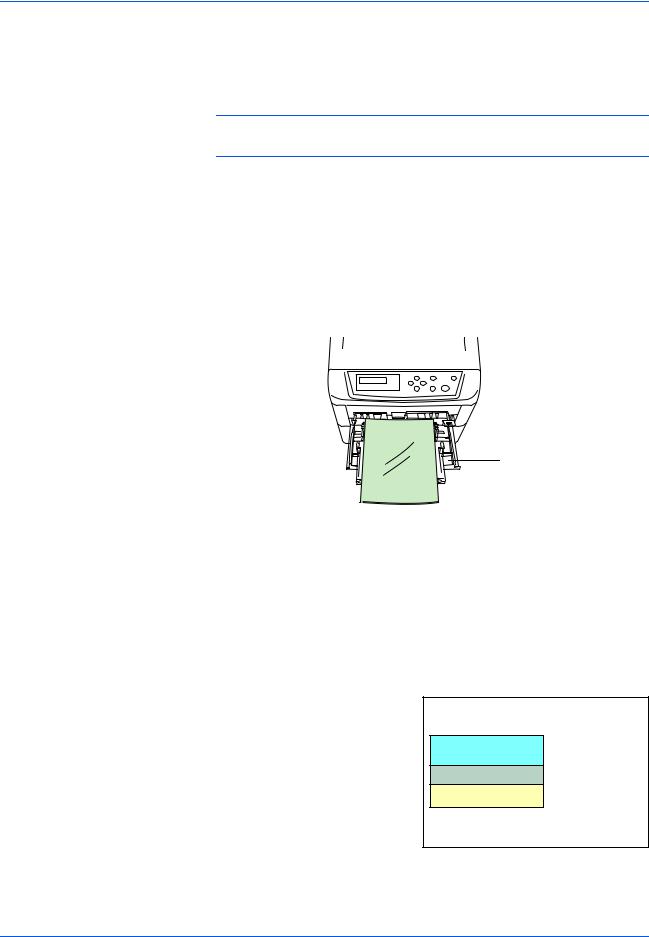
Handling Paper
Since the composition and quality of special paper vary considerably, special paper is more likely than white bond paper to give trouble during printing. No liability will be assumed if moisture and so forth given off during printing on special paper causes harm to the machine or operator.
NOTE: Before purchasing any type of special paper, test a sample on the machine and check that printing quality is satisfactory.
Transparency
Transparencies must be able to withstand the heat of fusing during the printing process. The recommended transparency product is 3M CG3700 (Letter, A4).
Transparencies must be placed on the MP tray with the long edge towards the printer. To avoid problems, stack transparencies face up on the faceup tray option.
MP Tray
When unloading transparencies (e.g., for clearing jams), hold them carefully by the edges to avoid leaving fingerprints on them.
Labels
Labels must be fed from the MP Tray.
The basic rule for printing on adhesive labels is that the adhesive must never come into contact with any part of the machine. Adhesive paper sticking to the drum or rollers will damage the machine.
Label paper has a structure comprising of three layers, as shown in the diagram. The top sheet is printed on. The adhesive layer consists of pressuresensitive adhesives. The carrier sheet (also called the linear or backing sheet) holds the labels until used. Due to the complexity of its composition, adhesive-
backed label paper is particularly likely to give printing problems.
1-8 |
ADVANCED OPERATION GUIDE |
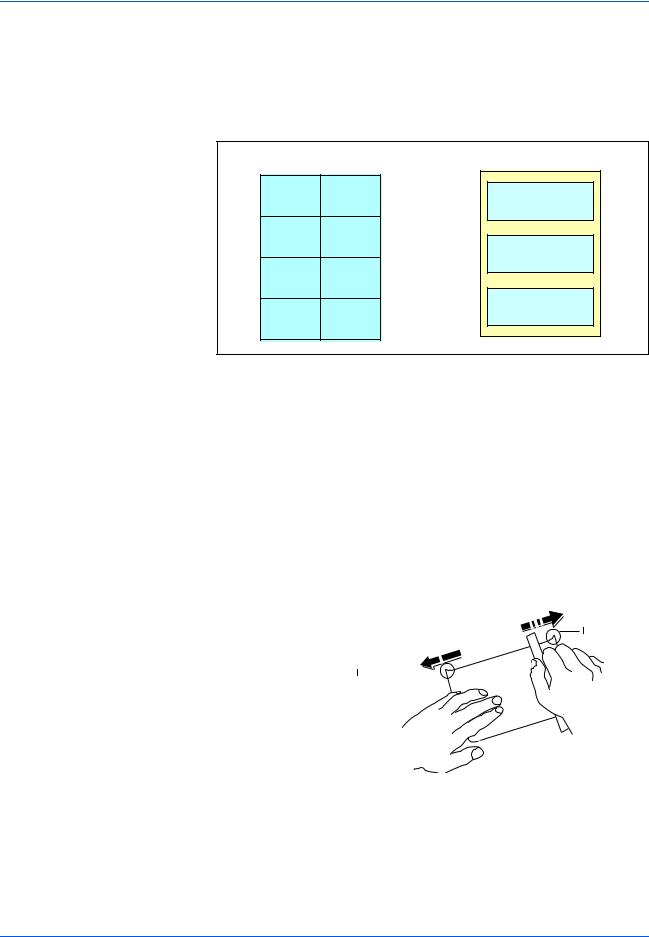
Handling Paper
Adhesive label paper must be entirely covered by its top sheet, with no spaces between the individual labels. Labels with spaces in between are liable to peel off, causing serious paper jam problems.
Some label paper is manufactured with an extra margin of top sheet around the edge. Do not remove the extra top sheet from the carrier sheet until after printing is finished.
Acceptable |
Unacceptable |
 Top sheet
Top sheet 
Carrier sheet 
The table below lists the specifications for adhesive label paper.
|
Item |
Specification |
|
|
|
|
Weight of top sheet |
44 to 74g/m² (12 to 20 lb/ream) |
|
|
|
|
Composite weight |
104 to 151g/m² (28 to 40 lb/ream) |
|
|
|
|
Thickness of top sheet |
0.086 to 0.107mm (3.9 to 4.2 mils) |
|
|
|
|
Composite thickness |
0.115 to 0.145mm (4.5 to 5.7 mils) |
|
|
|
|
Moisture content |
4 to 6% (composite) |
|
|
|
Postcards |
|
|
Fan the stack of |
|
|
postcards and align |
Rough Edge |
|
the edges before |
||
|
loading them in the  MP tray. Make sure Rough Edge
MP tray. Make sure Rough Edge
 the postcards you
the postcards you
are going to set are not curled. Feeding curled postcards may cause paper jams.
Some postcards have rough edges on the back (those are created when the paper is cut). In this case, put the postcards on a flat place and rub the edges with, for example, a ruler to smooth them.
ADVANCED OPERATION GUIDE |
1-9 |

Handling Paper
Envelopes
Envelopes should be fed in the face-up position, right edge first.
Since the composition of an envelope is more complex than that of ordinary paper, it is not always possible to ensure consistent printing quality over the entire envelope surface.
Normally, envelopes have a diagonal grain direction. See Paper Grain on
page 1-6. This direction can easily cause wrinkles and creases when
envelopes pass through the printer. Before purchasing envelopes, make a test print to check whether the printer accepts the envelope.
•Do not use envelopes that have an encapsulated liquid adhesive.
•Avoid a long printing session for envelopes only. Extended envelope printing can cause premature printer wear.
•If jams occur, try setting a lesser number of envelopes on the MP tray.
•To avoid jams caused by curled envelopes, stack no more than 10 printed envelopes on the output tray.
Thick Paper
Fan the stack of paper and align the edges before loading them in the MP tray. Some types of paper have rough edges on the back (those are created when the paper is cut). In this case, put the paper on a flat place and rub the edges once or twice with, for example, a ruler to smooth them. Feeding rough edged paper may cause paper jams.
NOTE: If the paper jams even after you smooth it out, load the paper in the MP Tray with the leading edge raised up a few millimeters as shown in the illustration.
Colored Paper
Colored paper should satisfy the same conditions as white bond paper, refer to Paper Specifications, on page 1-2. In addition, the pigments used in the paper must be able to withstand the heat of fusing during the printing process (up to 200°C or 392°F).
1-10 |
ADVANCED OPERATION GUIDE |

Handling Paper
Preprinted Paper
Preprinted paper should satisfy the same conditions as white bond paper, refer to Paper Specifications, on page 1-2.The preprinted ink must be able to withstand the heat of fusing during the printing process, and must not be affected by silicone oil.
Do not use paper with any kind of surface treatment, such as the type of paper commonly used for calendars.
Recycled paper
Select recycled paper that meets the same specifications as the white bond paper except for whiteness, refer to Paper Specifications, on page 1- 2.
NOTE: Before purchasing recycled paper, test a sample on the machine and check that the printing quality is satisfactory.
ADVANCED OPERATION GUIDE |
1-11 |

Handling Paper
Paper Type
The printer is capable of printing under the optimum setting for the type of paper being used.
Setting the paper type for the paper source from the printer’s operator panel will cause the printer to automatically select the paper source and print in the mode best suited to that type of paper.
A different paper type setting can be made for each paper source including the MP tray. Not only can preset paper types be selected, but it is also possible for you to define and select customized paper types. See Creating Custom Paper Type on page 2-70. The following types of paper can be used.
|
|
|
|
Paper source |
|
|
|
|
|
|
|
Paper Type |
|
|
Paper |
|
Duplex path |
|
|
MP tray |
Paper Weight |
(MP tray available only |
|
|
|
Cassette |
|||
|
|
|
|
in Cassette mode) |
|
|
|
|
|
|
|
|
|
|
|
|
|
Plain |
|
Yes |
Yes |
Normal 2 |
Yes |
Transparency |
|
Yes |
No |
Extra Heavy |
No |
Preprinted |
|
Yes |
Yes |
Normal 2 |
Yes |
Labels |
|
Yes |
No |
Heavy 1 |
No |
Bond |
|
Yes |
Yes |
Normal 2 |
Yes |
Recycled |
|
Yes |
Yes |
Normal 2 |
Yes |
Vellum |
|
Yes |
No |
Light |
No |
Rough |
|
Yes |
Yes |
Normal 2 |
Yes |
Letterhead |
|
Yes |
Yes |
Normal 2 |
Yes |
Color |
|
Yes |
Yes |
Normal 2 |
Yes |
Prepunched |
|
Yes |
Yes |
Normal 2 |
Yes |
Envelope |
|
Yes |
No |
Heavy 1 (FS-C5015N/ |
No |
|
|
|
|
FS-C5030N) |
|
|
|
|
|
Heavy 2 (FS-C5025N) |
|
|
|
|
|
|
|
Cardstock |
|
Yes |
No |
Heavy 2 |
No |
Coated |
|
Yes |
No |
Normal 2 |
No |
Thick |
|
Yes |
No |
Heavy 1 |
No |
High quality |
|
Yes |
Yes |
Normal 2 |
Yes |
Custom 1 (to 8)† |
|
Yes |
Yes |
Normal 2 |
Yes |
Yes: Can be stored |
No: Cannot be stored |
|
|
||
|
|
|
|
|
|
†.This is a paper type defined and registered by the user. Up to eight types of user settings may be defined. For details on Creating Custom Paper Type on page 2-70.
1-12 |
ADVANCED OPERATION GUIDE |
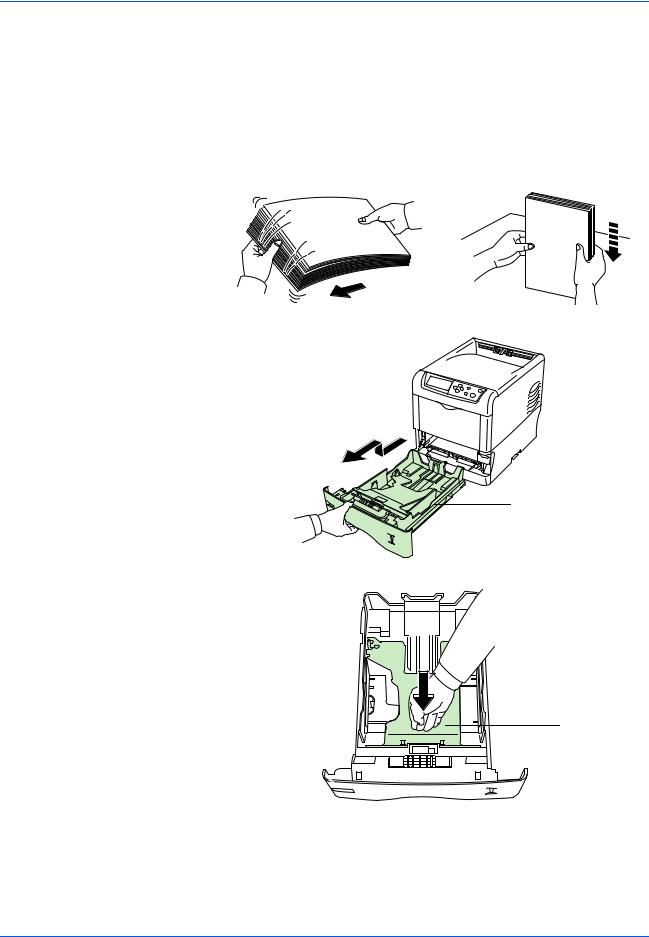
Handling Paper
Loading Paper
The following explains the procedure for loading paper in the cassette and the MP tray.
Loading Paper into the Cassette
1 |
Fan the media (paper/transparencies), then tap it on a level surface to |
|
avoid media jams or skewed printing. |
2 |
Pull the paper cassette all the way out of the printer. |
Paper Cassette
3 |
Push the bottom plate down until it locks. |
Bottom Plate
ADVANCED OPERATION GUIDE |
1-13 |
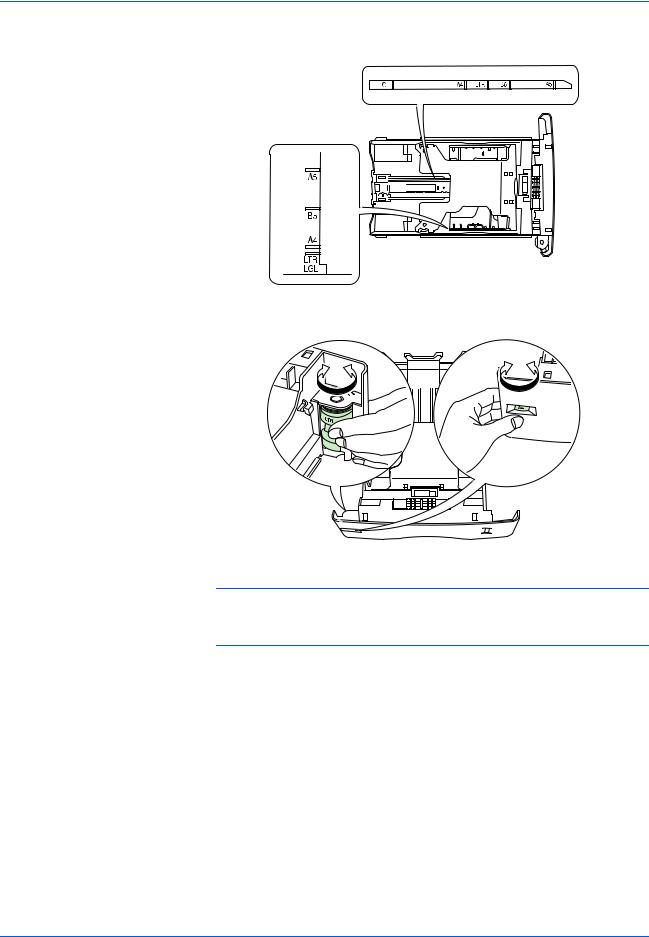
Handling Paper
Standard paper sizes are marked on the inside of the paper cassette.
4 |
Turn the paper size dial so that the size of the paper you are going to use |
|||||
|
appears in the paper size window. |
|||||
|
|
|
|
|
|
|
|
|
|
|
|
|
|
|
|
|
|
|
|
|
|
|
|
|
|
|
|
|
|
|
|
|
|
|
|
|
|
|
|
|
|
Paper Size Dial |
Paper Size Window |
NOTE: When the paper size dial is set to OTHER the paper size must be set into the printer on the operator panel. See Setting the Cassette Paper Size on page 2-63.
1-14 |
ADVANCED OPERATION GUIDE |
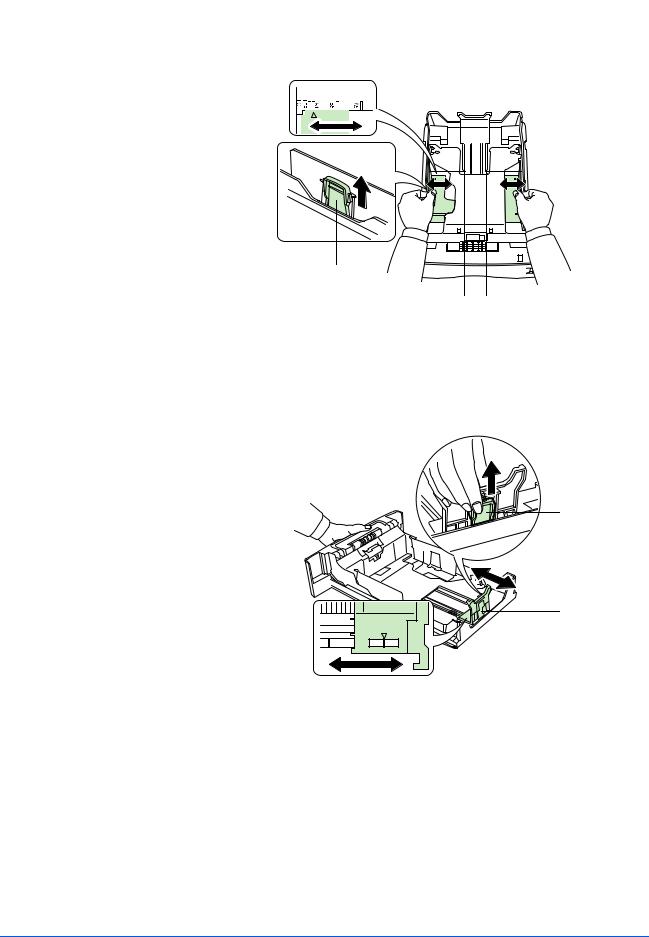
|
|
|
|
|
|
|
Handling Paper |
|
|
|
|
|
|
|
|
5 |
Pull the release lever on the left side guide and slide to the desired paper |
||||||
|
size. |
||||||
|
|
|
|
|
|
|
|
|
|
|
|
|
|
|
|
|
|
|
|
|
|
|
|
|
Release Lever |
|
Paper Guides |
6 |
Pull the release lever and slide the paper stopper to the desired paper size. |
When using non-standard size paper, move the paper guides and paper stopper all the way out, insert the paper, then adjust the paper guides and paper stopper to the size of the paper. Adjust them so that they are in light contact with the paper.
Release Lever
Paper Stopper
|
|
ADVANCED OPERATION GUIDE |
1-15 |
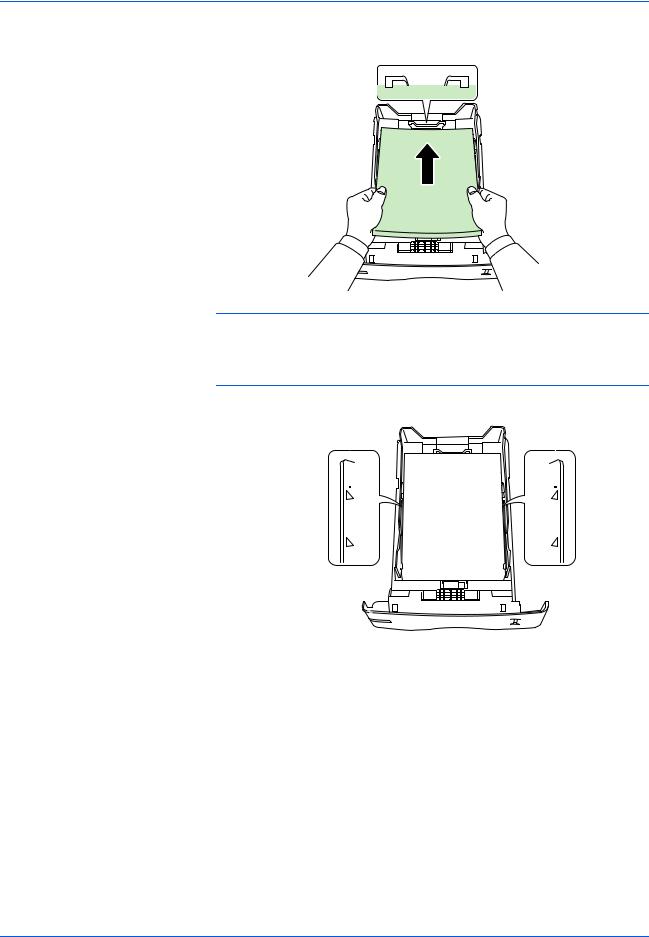
Handling Paper
7 |
Slide the paper into the paper cassette. |
|||||
|
|
|
|
|
|
|
|
|
|
|
|
|
|
NOTE: Do not load more paper than will fit under the load limits on the paper guides.
The paper cassette will hold approximately 500 sheets of 80g/m² (21 lb.) paper with a thickness of 0.11mm.
Load Limit |
|
Load Limit |
||||
|
|
|
|
|
|
|
|
|
|
|
|
|
|
|
|
|
|
|
|
|
|
|
|
|
|
|
|
|
|
|
|
|
|
|
|
|
|
|
|
|
|
|
|
|
|
|
|
|
|
|
|
|
|
|
|
|
|
|
|
|
|
|
|
|
|
|
|
|
|
|
|
|
|
|
|
|
1-16 |
ADVANCED OPERATION GUIDE |
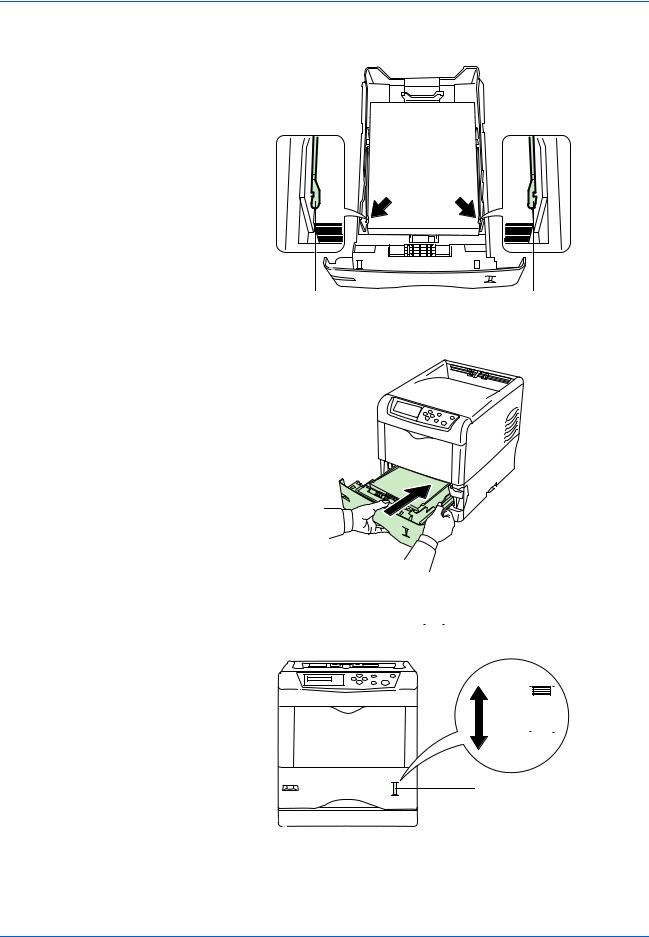
Handling Paper
8 |
Set the stack of paper so that it is under the clips as shown. |
Clip |
Clip |
9 |
Insert the paper cassette into the slot in the printer. Push it straight in as |
|
far as it will go. |
There is a paper gauge on the right side of the front of the paper cassette to indicate the remaining paper supply. When paper is exhausted, the
pointer will go down to the level of |
|
(empty). |
|
|
|
||
|
|
|
|
||||
|
|
|
|
|
|
|
|
|
|
|
|
|
|
|
|
|
|
|
|
|
|
|
|
|
|
|
|
|
|
|
|
|
|
|
|
|
|
|
|
|
|
|
|
|
|
|
|
|
|
|
|
|
|
|
|
|
|
|
|
|
|
|
|
|
|
|
|
|
|
|
|
Paper Gauge
ADVANCED OPERATION GUIDE |
1-17 |
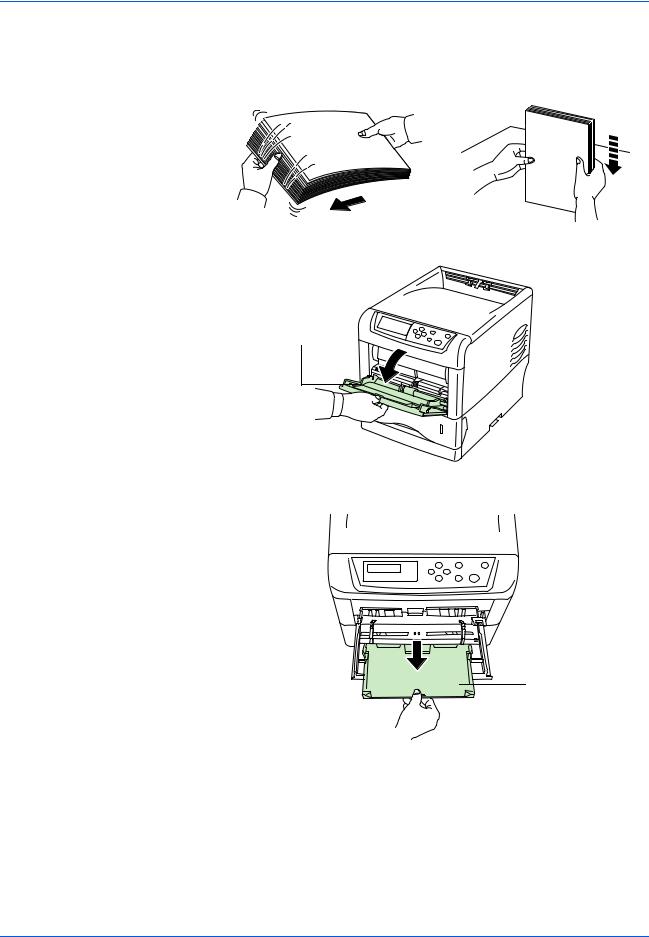
Handling Paper
Loading Paper into the MP (Multi-Purpose) Tray
1 |
Fan the media (paper/transparencies), then tap it on a level surface to |
|
avoid media jams or skewed printing. |
2 |
Pull the MP tray towards you until it stops. |
MP Tray
3 |
Pull out the subtray. |
Subtray
1-18 |
ADVANCED OPERATION GUIDE |
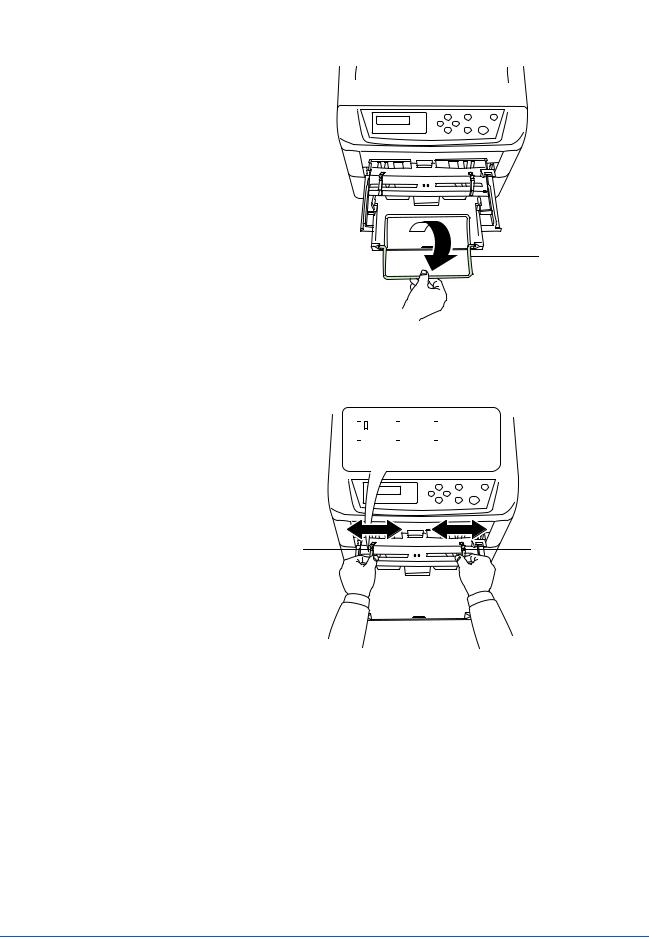
|
Handling Paper |
|
|
4 |
Flip the support wire when you load Legal size paper. (U.S.A. only) |
Support Wire
5 |
Adjust the position of the paper guides on the MP tray. Standard paper |
||||||||||
|
sizes are marked on the MP tray. For standard paper sizes, slide the |
||||||||||
|
guides to the position marked correspondingly. |
||||||||||
|
|
|
|
|
|
|
|
|
|
|
|
|
|
|
|
|
|
|
|
|
|
|
|
|
|
|
|
|
|
|
|
|
|
|
|
|
|
|
|
|
|
|
|
|
|||
|
|
|
|
|
|
|
|
|
|||
|
|
|
|
|
|
|
|
|
|
|
|
|
|
|
|
|
|
|
|
|
|
|
|
|
|
|
|
|
|
|
|
|
|
|
|
|
|
|
|
|
|
|
|
|
|
|
|
|
|
|
|
|
|
|
|
|
|
|
|
Paper Guide |
Paper Guide |
ADVANCED OPERATION GUIDE |
1-19 |
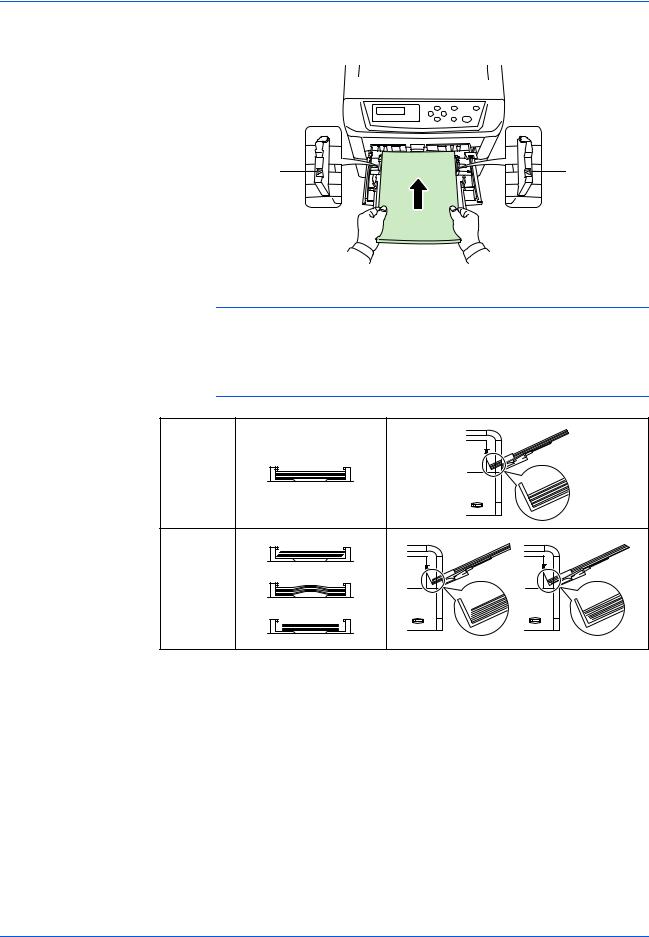
Handling Paper
6 |
Align the paper with the paper guides and insert as far as it will go. |
Load Limit |
Load Limit |
NOTE: Do not load more paper than will fit under the load limits on the inside of the MP tray.
If the paper is considerably curled in one direction, for example, if the paper is already printed on one side, try to roll the paper in the opposite direction to counteract the curl. Printed sheets will then come out flat.
Correct
Incorrect
7 |
Set the MP tray paper size on the printer’s operator panel. Refer to Setting |
|
MP Tray Paper Size on page 2-61. |
1-20 |
ADVANCED OPERATION GUIDE |

2 Using the Operator Panel
This chapter contains explanations on the following topics:
• |
General Information...................................................... |
2-2 |
• Understanding the Operator Panel............................... |
2-3 |
|
• Canceling a Printing Job ............................................ |
2-10 |
|
• Using the Menu Selection System .............................. |
2-11 |
|
• |
Status Pages .............................................................. |
2-15 |
• |
e-MPS ........................................................................ |
2-18 |
• Changing the Interface Parameters ........................... |
2-29 |
|
• |
Making Default Settings ............................................. |
2-37 |
• |
Pagination .................................................................. |
2-44 |
• |
Setting Print Quality.................................................... |
2-49 |
• Operating the Storage Device .................................... |
2-51 |
|
• |
Paper Handling........................................................... |
2-60 |
• Selecting Monochrome or Color Printing.................... |
2-74 |
|
• |
Reading Life Counters................................................ |
2-75 |
• |
Other Modes............................................................... |
2-77 |
ADVANCED OPERATION GUIDE |
2-1 |

Using the Operator Panel
General Information
This chapter provides the information you need to configure the Ecosys Color printer. In general you need to use the operator panel only to make default settings. You can make most changes to the printer settings using the printer driver through the application software.
NOTE: Changes to printer settings made using a software application override changes made using the operator panel.
You can also rely on other printer utilities such as KM-NET for Clients if you need to change settings that are not available on the printer driver. It will allow remote access to printer settings. Printer utilities are supplied in the CD-ROM supplied with the printer.
The chapter describes the operator panel in detail, including its menus and the procedures for changing various printer settings.
2-2 |
ADVANCED OPERATION GUIDE |
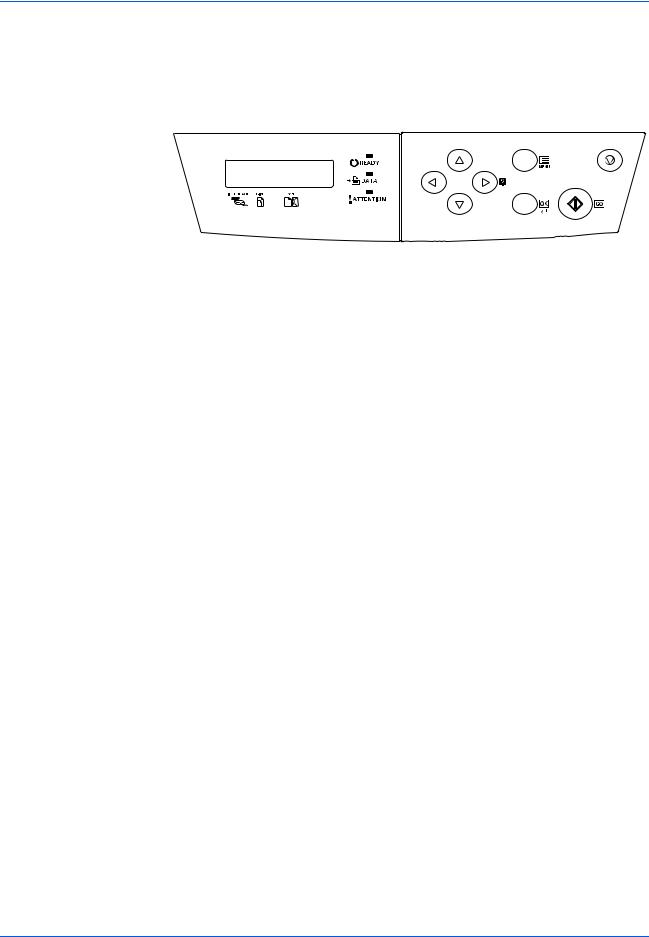
Using the Operator Panel
Understanding the Operator Panel
The operator panel on the top of the printer has a 2-line by 16-character liquid crystal display (LCD), eight keys, and three indicators (LED).
Messages that appear on the display and functions of indicators and keys are explained in this chapter.
Message Display
The message display on the operator panel shows:
•Status information, the ten messages listed below which are displayed during normal operation.
•Error codes, when the printer requires the operator’s attention; as explained in the Operation Guide.
ADVANCED OPERATION GUIDE |
2-3 |

Using the Operator Panel
|
Status Information |
|
|
Message |
Meaning |
|
|
Self test |
The printer is performing self-diagnostics after power-up. |
Please wait |
The printer is warming up and is not ready. |
|
When the printer is switched on for the first time, this message will take several |
|
minutes. |
|
|
Please wait |
Toner is currently being replenished. This message may be displayed during |
(Adding toner) |
continuous printing of a large volume of pages which require a large amount of |
|
toner such as with photographs, etc. |
|
|
Please wait |
The color calibration function is being performed automatically as you powered |
(Calibrating) |
on the printer. |
|
You can also execute this function manually on the operator panel. For details, |
|
see Color Calibration on page 2-90. |
|
|
Ready |
The printer is ready to print. |
Processing |
The printer is receiving data to print. This is also shown when the printer is |
|
reading a memory card, hard disk or RAM disk. |
|
|
Sleeping |
The printer is in Auto Sleep. The printer wakes from Auto Sleep whenever a key |
|
on the operator panel and [GO] is pressed, the cover is opened or closed, or a |
|
print job is received. The printer then warms up and goes on-line. For details on |
|
Auto Sleep, see Sleep Timer Timeout Time on page 2-79. |
|
|
Cancelling data |
Jobs inside the printer are being canceled. To cancel a job, see Canceling a |
|
Printing Job on page 2-10. |
|
|
Skipping data |
The printer is skipping the data. |
Waiting |
The printer is waiting for the rest of print job before completing the last page. |
|
Pressing [GO] allows you to obtain the last page immediately. See below. |
FormFeed TimeOut |
The printer is printing the last page after a waiting period. |
Error codes
See the Troubleshooting section in the Operation Guide.
2-4 |
ADVANCED OPERATION GUIDE |
